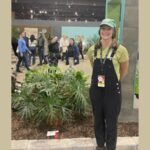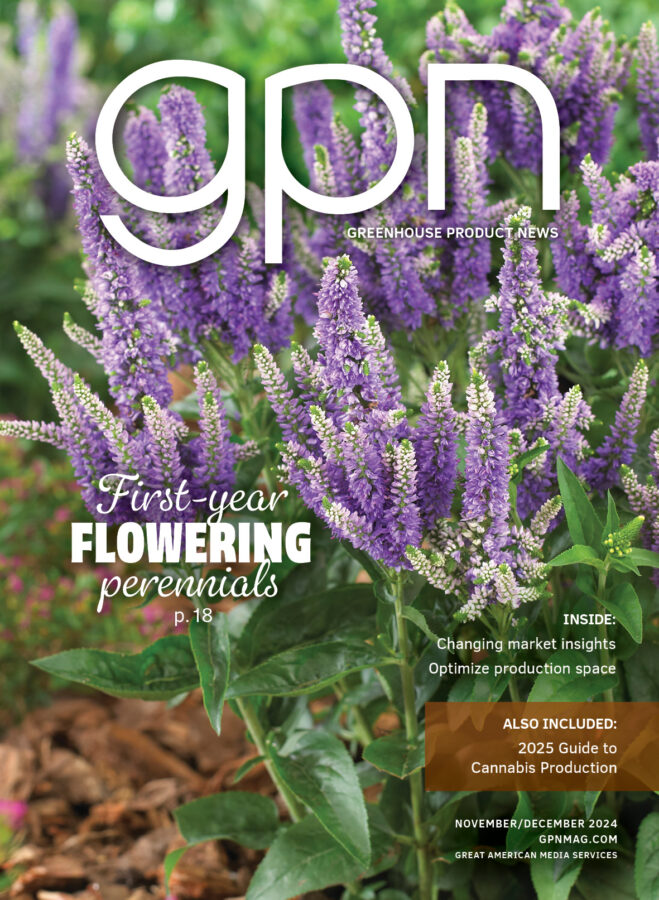
Perennial Solutions: Schizachyrium scoparium ‘Standing Ovation’
Many growers and landscapers successfully produce and utilize a number of mainstream warm season ornamental grasses such as Miscanthus and Panicum. There are several additional warm season grass species that have great characteristics and potential, but currently they are not as widely grown.
Schizachyrium scoparium ‘Standing Ovation’ is a great ornamental grass that offers both ease of production and great ornamental attributes. It was discovered by North Creek Nurseries of Landenberg, Pa. ‘Standing Ovation’ has all of the benefits of the species as well as several notable improvements. Some of the most prevalent differences are the thickness of the leaf blades and the overall sturdiness of the plants.
‘Standing Ovation’ is referred to as “the little bluestem that keeps you on your feet,” referring to its ever-changing appearance and lasting presence in the landscape. Spiky bluish-green stems emerge in the late spring. During the summer, its sturdy, upright stems have a blue cast with a dark purple coloration near the base of the plant. As fall approaches, the leaves and stems transition to a sizzling display of vivid purples, vibrant reds and autumn oranges. The seed heads add texture to fall and winter landscapes.
Schizachyrium is a clump-forming warm season ornamental grass with a height of 3 to 4 feet when in bloom, and maintains tidy 12-inch wide clumps. It tolerates a wide range of growing conditions including poor, dry soils. Unlike the species, ‘Standing Ovation’ continues to stand upright even when kept slightly moist or with too much fertility. Although the trade currently underutilizes this grass, it can be grown successfully throughout USDA Hardiness Zones 3 to 8. Little bluestem is drought tolerant once established and resistant to deer feeding.
With its foliage colorations and habit, Schizachyrium ‘Standing Ovation’ provides vivid displays of multi-seasonal interest. Its ease of production and shelf appearance are also appealing to perennial growers. Little bluestem is best utilized as a vertical accent in perennial borders, as a screen in mass plantings or to provide spectacular displays in decorative containers. When looking for something new to add to ornamental grass programs, ‘Standing Ovation’ is definitely worth considering.
Propagation
Schizachyrium ‘Standing Ovation’ is vegetatively propagated by means of tissue culture by licensed propagators. Since a plant patent is being sought (PPAF – Plant Patent Applied For), unlicensed propagation of this cultivar without permission of the applicant is currently prohibited.
Production
‘Standing Ovation’ is well suited for production in 2-quart to 2-gallon containers. It grows slightly slower than many of the other commonly produced warm season grasses and will require slightly more production time. For this reason, growers targeting mid-spring to early-summer sales are encouraged to bulk them during the summer the year prior to the intended market date.
Schizachyrium performs well in moist, well-drained growing mixes. Many commercially available peat- or bark-based growing mixes work well provided there is good water-holding ability and adequate drainage. Most growers elect to grow ornamental grasses in mixes containing bark; this is especially beneficial to growers overwintering them in the final container or when holding crops for long durations.
While transplanting, avoid planting little bluestem too high or too low; always plant to match the original soil line of the liner with the growing mix of the final container. After planting, provide water as needed to keep the growing mix uniformly moist, but not consistently wet.
Once the plants are fully rooted, they can be allowed to dry out slightly more between irrigations. Established containers require average to above-average amounts of irrigation. When irrigation is needed, water thoroughly and allow them to dry slightly between waterings.
Similar to other warm season grasses, Schizachyrium performs best when grown with moderate fertility levels. Growers using water-soluble fertilizers either apply 250 to 300 ppm of nitrogen as needed or feed with a constant liquid fertilization program using rates of 100- to 150-ppm nitrogen with each irrigation. Controlled release fertilizers can be applied as a top-dress onto the media surface using the medium labeled rate or incorporated into the growing mix prior to planting at a rate equivalent to 1.2 to 1.4 pounds of elemental nitrogen per yard of growing medium. During production, the pH of the media should be maintained between 6.0 and 6.5.
Being a tall, upright ornamental grass, many growers may be interested in reducing the overall plant height to maximize shipping efficiencies. Providing adequate spacing between containers, avoiding over-fertilizing and irrigating the plants are the first steps growers can use to manage plant height.
Unfortunately, to my knowledge there have not been any plant growth regulator (PGR) efficacy studies performed on Schizachyrium. If additional height control is desired, consider trialing applications of PGRs. Based on results obtained from other warm season grass species, foliar applications of PGRs typically are ineffective. Therefore, consider trialing drench applications of 1.0- to 1.5-ppm uniconazole (Concise or Sumagic) or 6- to 10-ppm paclobutrazol (Bonzi, Paczol or Piccolo). Apply PGR drenches by the time the plants are 6 to 12 inches tall; later applications are likely to be less effective and may not provide the desired results.
Pests and Diseases
For the most part, Schizachyrium can be grown without the incidence of pests or diseases. The primary pests of little bluestem are aphids, spider mites and spittlebugs. Growers may also observe leaf spots and/or crown or root rots on occasion. Avoiding extended periods when the foliage remains wet and ensuring the root zones dry out between irrigations will greatly reduce the occurrence of these pathogens. For the most part, these insects and pathogens do not require preventative strategies and can be managed upon early detection.
Temperatures and Scheduling
The exact requirements for flowering have not yet been determined. Since little bluestem naturally flowers in the fall and the plants are significantly taller when in bloom, most perennial growers do not market them as flowering plants. When maintaining 65° to 75° F throughout crop production, 1-gallon pots of non-flowering Schizachyrium can be produced from large plugs in 9 to 11 weeks. Smaller-sized liners (50-cell) will take longer to finish. When producing large container sizes (2-gallon) or when sales are needed by early summer, it is usually best to plant them during the late summer the year before they are to be marketed.
Availability
Liners of Schizachyrium ‘Standing Ovation’ can be obtained from a number of licensed propagators including North Creek Nurseries (www.northcreeknurseries.com) and Hoffman Nursery (www.hoffmannursery.com).


 Video Library
Video Library 



















